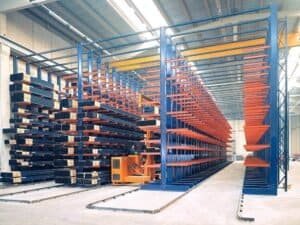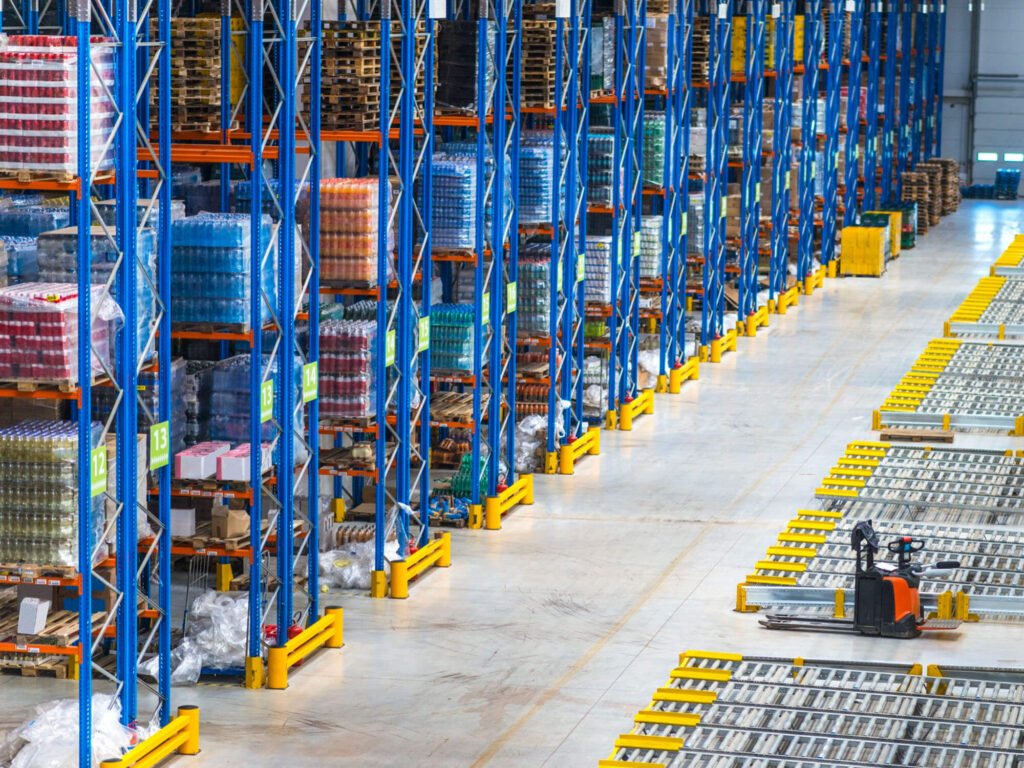Is your warehouse limited on space, yet still needs quick access to each pallet inside it? If yes, then VNA pallet racking is tailored to suit your needs. The system permits storage of greater quantities of stock through the use of very narrow aisles and vertical racks. Most importantly, safety and speed are not compromised.
Thus, this comprehensive guide covers the VNA racking system’s functionalities, their impact on efficiency, and their benefits relative to the need for expanded storage. So, keep reading!
1) What Is VNA Pallet Racking?
VNA (Very Narrow Aisle) pallet racking is a kind of storage system that allows for the storage of more items in a given space. Let’s explore its components for a better understanding!
- Components of VNA pallet racking
i) Upright Frames: They are made of metal and are vertical, making them look like the ladder’s legs. These frames carry the entire weight of the storage system, so they physically support every single system component.
Based on the pallet stacking preferences, these frames are 5 to 12 meters, which helps connect and stabilize the entire system.
ii) Beams: Once your upright frames are set, you can connect them with beams. Beams are horizontal bars that are as strong as they are thick. Each pair of beams forms a shelf between the frames.
Also, they are capable of holding from 500 to 2,000 kg each. This makes beams ideal for supporting your goods as they are strong, ensuring they stay safe and off the ground.
iii) Pallet supports: Once beams are set, you can add supports to the pallets. Pallet supports are bars placed under each pallet to provide additional balance.
iv) Guide rails: Due to the narrow aisles, your forklift might have limited space to maneuver. The solution to that problem is guide rails. Guide rails, which are placed on either side of the aisle floor, are metal tracks that keep your forklift from drifting too far left or right. They ensure safe and straight movement through the aisle.
2) How Does VNA Pallet Racking Work? Exploring its key features
Now, you are probably asking yourself how a Very Narrow Aisle (VNA) pallet racking system operates. It is more straightforward than what most individuals perceive. Let’s simplify everything into steps so you can picture a warehouse and everything in it.
Step 1: Pallet arrival
The first step is the transportation of the pallet to a warehouse for storage purposes. With VNA systems, there is a great deal of space saving achieved with the narrow (1.6 to 2 metres) aisle configuration. As noted, aisle means a space between two rows of racks.
Step 2: Collection with a specialised forklift
Your pallet racking systems will need VNA forks, turret, and articulated forklifts.
- Turret trucks: These trucks have a head that can rotate to the left and to the right, which means that they do not have to turn as a whole in order to change directions.
- Articulated forklifts: These have the ability to rotate in the center which is useful for tight areas.
Step 3: The forklift operates along a guided pathway.
However, in confined areas, the forklift needs either a metal rail guide or a wire guide along the floor.
- Guide rails, or metal tracks placed on the floor, help the forklift follow a straight path.
- Wire guidance is when a wire is placed on the ground that the forklift has sensors to follow.
This assists in avoiding collisions with racks while maintaining a straight trajectory.
Step 4: The pallet is precisely lifted to the required position.
The forklift can now navigate through narrow aisles, unlock the correct pallet, and place it on a shelf in a high bay rack, which is tall. Here, keep in mind that every palletized load has a fixed location on the rack, which assures that they are not mixed up, meaning they are not put on top of each other.
Step 5: The pallet is taken out the same way
During later times, when the pallet is required, the forklift will navigate back to the narrow corridor, pick the pallet without risk, and return it to the user. That’s your VNA racking system – you can store more, grab higher items quickly, and even in small areas, greatly organized.
So, if you want to install high-quality and reliable, then look no further than L-racking. We have been manufacturing VNA pallet racking for more than 16 years. Moreover, our VNA pallet racking has passed ISO9001, CE, TUV, and AS4084 certifications, so the quality of our products is trustworthy.
3) Benefits of VNA Pallet Racking
Hopefully, now you are clear about VNA pallet racking. Let’s explore how VNA benefits and supports you in streamlined warehouse operations.
+ Maximized Storage Density: As stated previously, VNA racking reduces the width of the aisles to 1.6 to 2 meters as compared to the 3 to 4 meters used in regular racking systems. This upgrade allows the addition of more racks and the utilization of vertical warehouse space. Thus, every square meter of storage space becomes more productive.
+ Improved Inventory Accessibility: Along with space efficiency, VNA racking systems offer full access to every pallet stored, also known as full selectivity. Thus, even with the narrow aisles designed, pallet retrieval is easy. This system becomes invaluable, especially when various goods are stored on different racks.
+ Operational Streamlining: In addition, the vertical narrow aisle layout allows the workers to pick and place items quickly. Also, forklifts utilize straight-line travel, and there are no sharp turns, which greatly improves fuel efficiency and energy consumption.
+ Safe and Organized Storage System: Safety is another key advantage. Wire guides or guide rails, which necessitate forklifts to move in straight lines, thus reducing the possibility of accidents, rack and pallet damage.
To conclude, VNA pallet racking allows for smarter, faster, safer, and more efficient product access and retrieval, with the added benefit of maintaining the same floor space.
4) Comparison: VNA vs Other Racking Systems
| VNA Racking | Selective Racking | Double Deep Racking | Drive-In Racking | |
| Aisle Width | 1.6–2 meters | 3–4 meters | 3–4 meters | Minimal (no aisles inside lanes) |
| Storage Density | High (up to 50% more pallets) | Low to Medium | Medium to High | Very High |
| Accessibility (Selectivity) | 100% (each pallet accessible) | 100% | 50% (rear pallets blocked) | Low (LIFO system) |
| Equipment Needed | Special forklifts (turret/VNA trucks) | Standard forklifts | Reach trucks | Standard or drive-in forklifts |
| Safety Features | Guide rails or wire guidance | No special guidance | No special guidance | Higher risk of damage (deep entry) |
| SKU Variety Handling | High | High | Medium | Low |
| Best for | Tight spaces with many SKUs | General storage needs | Fewer SKUs with moderate volume | Bulk storage of a few SKUs |
5) Limitations and Considerations
While VNA pallet racking systems can be advantageous for space optimization, there are critical considerations that require your attention. Let’s begin with the cost, which is not for the faint-hearted.
! Increased Equipment Costs: To begin with, specialized forklifts are required, such as turret forklifts. These typically cost two to three times that of standard forklifts. Furthermore, if guide rails or wire-guided systems are installed, that adds more to the expense.
! Requires Skilled Forklift Operators: In addition, as the VNA forklift system has restrictions of operating within cramped 1.6 to 2 meters wide aisles, employees hired need to be trained. Without properly trained personnel, operating within such a limited space with pallets can be dangerous.
! Limited to Specific Forklift Models: Moreover, not all forklifts can be used with this system. VNA turret and articulated trucks are a must. Otherwise, new machines would be required, which is an additional cost that can be avoided if the existing machines are compatible.
! Potential Requirement for Extra Strength to Floors: In addition, guiding forklifts requires appropriate space, which would need to be properly reinforced. The structure is required to bear both the racking and rail, which increases the need for a solid foundational framework.
! Not Ideal for Very Busy Areas: Lastly, where freight-moving activity is intensive, for instance, in the reception or dispatch warehouse zones, the use of VNA racking may not be ideal. Due to the limited width of the aisles, the flow of activity is heavily bottlenecked. Things need to be orderly, because if not, delays will be commonplace.
To summarize, VNA pallet racking systems provide excellent space-saving opportunities, but there are very important considerations that must not be overlooked when making a decision.
6) How to Choose the Right VNA System for Your Warehouse?
While planning a VNA (Very Narrow Aisle) racking system, you cannot choose any layout. It depends on certain zones of your warehouse and your daily operations. Here’s what to keep in mind:
➤ Warehouse Height and Overall Space: Check your warehouse height for starters. If it is between 8 to 12 meters high, then VNA racking will enable you to take full advantage of the vertical height. However, keep in mind that rails and heavy forklifts require a smooth, solid floor, so you may need to strengthen it for safety reasons.
➤ SKU Count and Picking Rate: Also, consider your products. If you have a large variety of products (SKUs) and need to pick them frequently, then VNA racking is ideally suited. It provides 100% direct access to every pallet, so your team does not spend time on relocating stock.
➤ Future Automation Considerations: Also, ask yourself if you plan to implement automated picking and retrieval systems in the foreseeable future. VNA systems are highly compatible with automated forklifts and shuttles, meaning your system could be expanded in line with the growth of your business.
➤ Safety, Maintenance, and Training: Last, but not least, safety is a concern. Drivers will require a specific skill set and training due to the narrow aisles. Moreover, schedule your preventative maintenance for forklifts and other equipment, such as rails and racks, to enhance their reliability and restore them to optimum working conditions.
Following these steps will allow you to make the best decision that accommodates your space, workflow, and objectives.
7) FAQs
i) Are you able to change the height of the VNA racks?
Of course. VNA racks are fully adjustable. You can change beam levels to different pallet sizes and varying storage requirements over time without the need to replace the entire system.
ii) Are VNA racking systems safe to use?
Yes, when installed correctly, they are perfectly safe. It often includes floor guidance systems that help with avoiding forklift accidents and keep each pallet in a fixed position, which is easy to access.
iii) Does VNA Racking require specific flooring?
Yes, the floor must be flat and provide sufficient support for the guide rails and heavy machinery. Any uneven surfaces may pose balance challenges for the forklift, thus creating a safety hazard.
iv) What is the tallest height that VNA racks can reach?
VNA racks can be as tall as your warehouse ceiling permits, which is typically between 12 to 17 meters. This design vertically optimizes storage without increasing floor space.
7) Final Words
In general, VNA pallet racking systems maximize warehouse space utilization and, at the same time, ensure high accessibility to goods. If your current systems are space inefficient and cause operational slowdowns, then there is definitely a need to upgrade.
Well! You can reach out to a reputable supplier like L Racking. We are China’s best warehouse pallet racking manufacturer, having nearly two decades of experience in the warehouse storage racking industry. So, contact us today for an instant quote.




